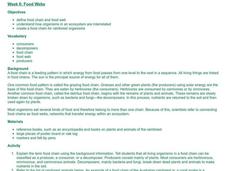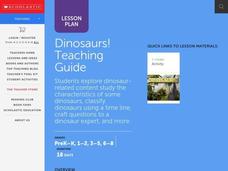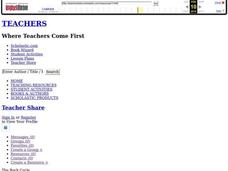Curated OER
What things let Light Pass Through?
Second graders classify objects according to how well light can pass through them and predict how well objects will transmit light. They experiment with objects to verify predictions while collecting, recording, and interpreting data...
Curated OER
An Introduction to the Ocean World
Students comprehend how the organisms that exist within the ocean biome, and categorizing each into producer, consumer, or decomposer. They place various human actions under the headings of "hazard" or "help," illustrating how humans can...
Curated OER
Mythology Spreadsheet
Students read a large variety of myths and discuss the characters and their attributes found in mythology. Then they identify and learn to set up an appropriate spreadsheet program. Students also enter the data to the class spreadsheet...
Curated OER
QUIZ 1A: Nouns, People, Places, Animals, and Things
In this noun classification worksheet, students 25 nouns in the provided word bank and classify them in a graphic organizer according to common and proper nouns that that name people, places, or things.
Curated OER
Food Webs
Students research rainforest animals and use that information to make a flow chart to show the order in which energy is transferred through several organisms. They label the producers, consumers, and decomposers in their chart.
Curated OER
Recyclers to the Rescue
Fifth graders examine the concept of the food chain and define producer, consumer, herbivore, carnivore, and omnivore. They draw a food chain for a mouse and discuss the different organisms involved in the chain, and conduct an...
Curated OER
Hide and Seek Science
Pupils examine macro-invertebrates in order to better understand their link to the food web. Working in groups, they record observations of several areas of a stream or river, collect samples from the river bottom, and identify the...
Curated OER
Extremophiles- Non-Fiction Reading Comprehension
In this extremophiles non-fiction reading learning exercise, students read a two page selection that describes the organisms known as extremophiles. They answer 10 questions based on the selection which include true or false, short...
Curated OER
Dinosaurs
Students will develop goals for inquiry. They will also improve content area reading and research skills. The context of studying dinosaurs will help learners to distinguish from organisms that live presently and those from the past...
Curated OER
Sound
First graders investigate sound and recognize the importance of hearing. They listen to and identify sounds in the environment, classroom, and on a pre-recorded tape. The students classify each type of sound and participate in a Sound...
Curated OER
Sorting and Using Materials
Students practice sorting and classifying objects. In groups, they choose a variety of materials and describe how each one looks and feels. They must agree on how to classify each object and share their groupings with the class. They...
Curated OER
Studying Species By Examining the Evolution of the Canidae Family
Pupils read an article on the characteristics of wolves and dogs then complete a phylogenetic tree of the canid family. They then write an essay justifying why or why not wolves and dogs should be classified as different species.
Curated OER
Plant Classification
Pupils share with the class how they think plants are classified and are assessed on their prior knowledge. They use a packet to complete throughout the week at their own pace, which includes various activities to familiarize themselves...
Curated OER
Vertebrate Skeletons
In this biology worksheet, students examine the human skeleton and then classify animal bones according to their similar function.
Curated OER
Biodiversity
In this biodiversity activity, students sort and classify animals by their observable features using a dichotomous key. Students then respond to questions about complete and incomplete metamorphosis.
Curated OER
Exploring the Beach
Students explore the beach. In this marine habitat instructional activity, students inspect sand grains, design beach profiles, classify marine life, and examine natural beach habitats. Students use spreadsheets to record data from their...
Curated OER
Sorting
Students identify how objects can be sorted or classified for easy access. In this sorting activity, students will investigate how letters, numbers, and symbols are used in sorting and classifying.
Curated OER
Worming Your Way Through the Soil
Students study soil, living and non-living particles in the soil, and learn about composting. In this soil study lesson, students study soil samples and discuss the living and non-living components of the soil. Students classify the...
Curated OER
The Rock Cycle
Students explore the concept of the rock cycle. In this geology lesson plan, students identify, classify, and observe three different types of rocks. Students then list and char the characteristics of their rocks.
Curated OER
Public Goods and Common Resources
In this economics worksheet, students respond to 3 short answer questions and complete a graphic organizer about public goods and common resources.
Curated OER
Is There A Fungus Among Us?
Sixth graders classify fungus into two different groups. In this fungus lesson, 6th graders collect as many pieces of fungus as possible. Students then classify these pieces of fungus as saprophytic or parasitic.
Curated OER
Understanding Content Vocabulary in Employment Ads
Students use worksheets and classified ads to improve their ability to interpret newspaper employment ads by learning to read and explain commonly used content vocabulary.
Curated OER
What Is A Plant?
Students explore plants. In this plant lesson, students examine organisms to determine which are plants. During this introductory lesson, students explore characteristics of living things.
Curated OER
Secrets of the Ocean Realm - Survival in the Sea
Students determine the sequential links in a marine food chain and identify the roles that various organisms play in this chain. Students develop charts as visual aids for illustrating marine food chains.

























